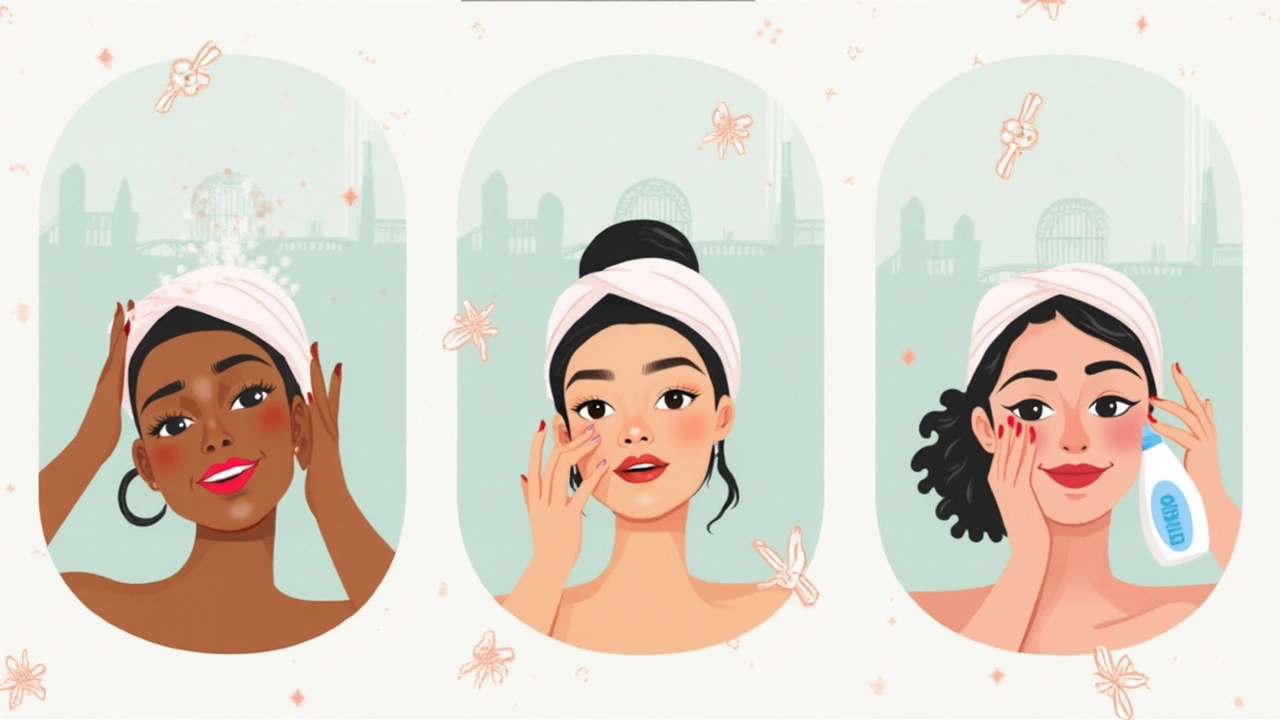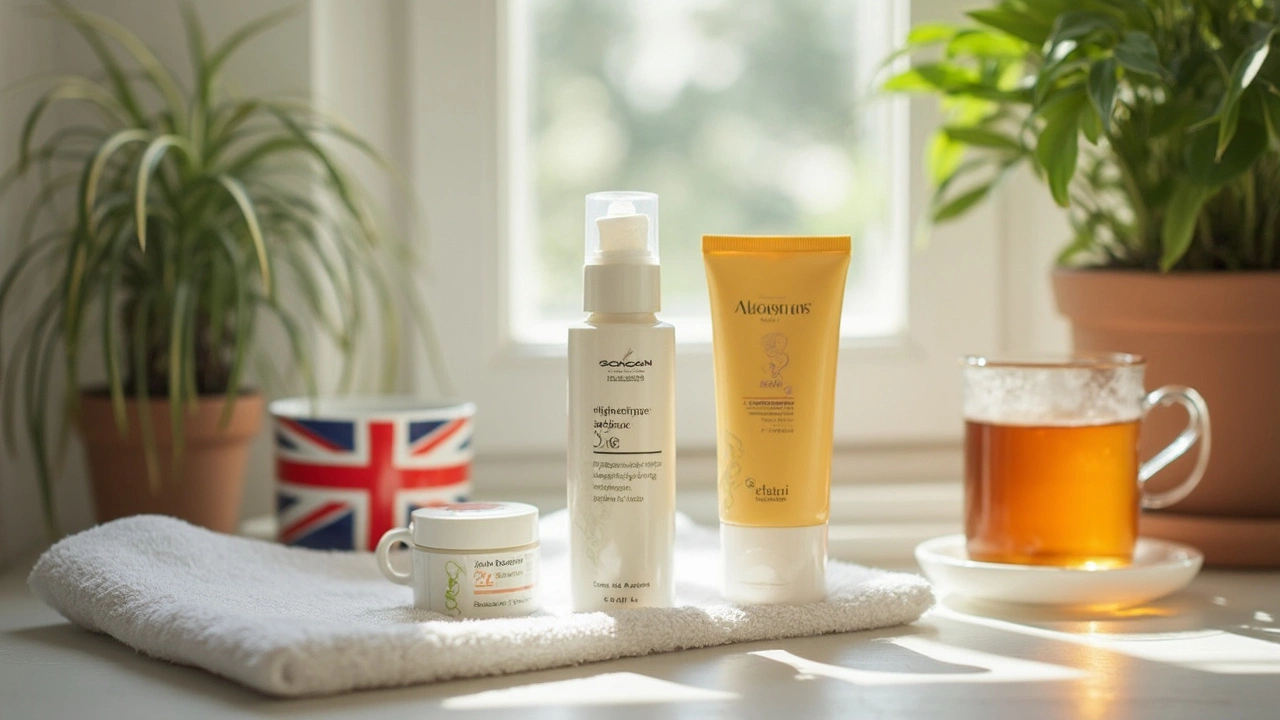Three steps. That’s all it takes to start seeing healthier skin, and honestly, most people overcomplicate it. You don’t need a shelf full of fancy bottles or a twenty-minute morning ritual. The basics—cleansing, moisturizing, and sun protection—make way more difference than any trend or pricey serum.
Sure, everybody’s skin is unique, but the reason these three steps work for nearly everyone is science. Cleanser removes the grime, moisturizer locks in what your skin actually needs, and sunscreen protects you from way more than just sunburn. And here’s a fact: skipping just one can mess with your skin way more than skipping your coffee.
You don’t have to guess which product is right or wonder how much you really need. Simple routines are easier to stick with, cut down on wasted money, and give you better results. So, why chase complicated when smart and simple works?
- Why Simple Skincare Works
- Step 1: Cleansing—Doing It Right
- Step 2: Moisturizing Without the Grease
- Step 3: Sunscreen—Not Just for Summer
- Tips for Keeping Your Routine on Track
Why Simple Skincare Works
Straight-up, your skin craves consistency way more than endless products. When you stick to the basics, your skin barrier stays happy, and that's what keeps things smooth, clear, and healthy. It’s weird, but more isn’t always better. Jumping from one trendy product to another can actually mess with the skin’s natural balance.
Here's the deal: most skin trouble—think breakouts, dryness, irritation—comes from overdoing it. Dermatologists see it all the time. Too many actives, harsh scrubs, or random face masks just overload your skin. Keeping your skincare routine basic makes it easier for your skin to repair itself, and you can quickly spot what works and what doesn't.
Ever noticed that French women, with their fuss-free routines, seem to have such effortless skin? Turns out, simple habits go a long way. Experts at the American Academy of Dermatology say even for people with acne or sensitive skin, a solid simple routine is the best starting point.
- Your wallet stays happy. You’re not spending on stuff you don’t need.
- No guesswork or overwhelm. Less confusion about what to use and when.
- Lower risk of irritation or allergic reactions. Fewer products, fewer chances for something to go wrong.
Numbers don’t lie. In a recent survey, about 64% of adults admitted to giving up complicated routines, saying they saw better results (and fewer flare-ups) by going back to basics.
| Skin Issue | Complicated Routine | Simple Routine |
|---|---|---|
| Breakouts | 67% noticed worse | 22% saw improvement |
| Redness | 48% reported more often | 17% reported less |
| Consistency | 29% could stick with it | 83% kept up long-term |
If you want to see changes—stick to three steps. Your skin will thank you, your bathroom counter will look less crowded, and chances are, you’ll finally see the glow you’ve been chasing.
Step 1: Cleansing—Doing It Right
Think of cleansing as hitting the reset button on your face. Whether you wear makeup or not, your skin picks up sweat, oil, and stuff from the air all day. If you skip this part, everything else you put on doesn’t work as well—and you can even clog up your pores. That’s why it’s the first step in every skincare routine worth following.
Here’s a quick look at how cleansing affects skin health:
| What Cleansing Does | Why It Matters |
|---|---|
| Removes dirt and oil | Prevents clogged pores and breakouts |
| Washes away pollutants | Reduces skin irritation |
| Preps skin | Helps moisturizer and sunscreen work better |
So, what’s the best way to do it? The trick is using a gentle cleanser, not just soap. Old-school bar soaps or harsh washes can strip away your skin’s natural oils, which can leave you feeling tight or dry. Dermatologists say you should wash your face twice a day—morning and night. Sweaty workout? Throw in an extra rinse.
- Go for lukewarm water. Hot water feels nice but damages your skin’s natural barrier.
- Use your fingertips, not a washcloth, to avoid scrubbing too hard.
- Stick to about 20-30 seconds of gentle massaging—don’t rush, but don’t linger either.
- Rinse well and pat your face dry with a clean towel. No need to rub.
If you’ve got super dry or sensitive skin, look for cleansers labeled “fragrance-free” and “hydrating.” Oily or acne-prone? A foaming or gel cleanser with salicylic acid can help keep breakouts away, but don’t overdo it—too much can backfire and make your skin produce even more oil.
One last thing: Avoid following TikTok “hacks” with crazy ingredients like lemon juice or baking soda—they can do more harm than good. Keep cleansing simple and let your skin do the rest.

Step 2: Moisturizing Without the Grease
Most people get flashbacks of heavy lotions and greasy faces when they hear “moisturizer.” Skip all that. These days, there’s a formula for every skin type, and you don’t have to look shiny or sticky to keep your skin healthy. This step in your skincare routine does not have to feel like a mess. The right moisturizer stops your skin from flaking, keeps it stronger, and yes, it even helps with oily skin—which, fun fact, sometimes just means you’re not hydrating enough.
Let’s get a few things straight about moisturizers:
- Hydrating isn’t just for dry skin. Even if you’re oily, you need moisture. Skin that’s dehydrated pumps out more oil to make up for it.
- Lightweight options exist. Look for “gel” or “oil-free” if you hate heavy creams. Ingredients like hyaluronic acid and glycerin pull water into your skin without the slick feeling.
- Avoid fragrances if you’re sensitive. Scented creams can irritate, especially if your skin is fussy. Unscented or “for sensitive skin” labels help avoid redness or bumps.
Here's a table with common moisturizer types matched with skin types, so you don’t have to guess in the aisle:
| Skin Type | Moisturizer Type | Main Ingredients |
|---|---|---|
| Oily | Gel Moisturizer | Hyaluronic Acid, Glycerin |
| Dry | Cream or Ointment | Ceramides, Shea Butter |
| Combination | Lotion | Dimethicone, Squalane |
| Sensitive | Fragrance-Free Cream | Colloidal Oatmeal, Panthenol |
Apply moisturizer while your skin is still slightly damp (after cleansing) for best results. This helps lock in all that water before it can evaporate. One pump or a pea-size dab is enough for most faces—you’re not icing a cake here. If you still feel sticky after a few minutes, try a lighter formula next time.
If you stick to this step every morning and night, you’ll notice fewer dry patches, a smoother texture, and even less shine if you’ve gone too matte before. Consistency works faster than anything fancy, and you’ll save money by not playing trial-and-error with every new bottle that hits store shelves.
Step 3: Sunscreen—Not Just for Summer
If you still think sunscreen is only for days at the beach or a blazing hot afternoon, here's a wake-up call. UV rays are sneaky. They get through clouds, car windows, even that light coming in through your living room. Dermatologists agree that using sunscreen every single day (yep, even cloudy days in winter) is one of the smartest moves for protecting your skin from damage, wrinkles, and even certain cancers.
The American Academy of Dermatology says you need at least SPF 30 for daily use. People often use way too little—so squeeze out about a nickel-sized amount for your face and add even more if you're covering your neck and ears. Remember, makeup and moisturizers with sunscreen can help, but if you're outside for more than two hours, you'll need to reapply.
Here are some quick tips that make daily sunscreen way less of a hassle:
- Pick a broad-spectrum sunscreen. This blocks both UVA (aging) and UVB (burning) rays.
- Go for formulas that match your skin type—gels for oily skin, creams for dry, and mineral sticks for sensitive folks.
- Don't forget easy-to-miss spots: ears, under the chin, hairline, and the back of your neck.
- If you sweat a lot or swim, choose water-resistant kinds and reapply every 80 minutes.
Here’s a wild fact: up to 80% of visible signs of aging are thanks to the sun, not your birthday. That’s why skincare routine experts always push sunscreen as your real “anti-aging” product. It isn’t about being perfect; it’s about protecting the skin you’ve got and not making things harder for yourself down the road.

Tips for Keeping Your Routine on Track
Sticking with your skincare routine is way easier when it fits smoothly into your life. Nobody wants another chore, especially before bed or when you’re rushing out the door in the morning. The trick is to make your routine as mindless as brushing your teeth. Here’s how you can make it work, even if you don’t have much time or patience:
- Keep it in sight: Store your skincare products where you’ll see them—next to your toothbrush, on your bathroom counter, or wherever you get ready. Seeing them is a solid reminder not to skip a step.
- Pick a regular time: Do your routine right after something you already do daily, like showering or brushing your teeth. This helps it become second nature.
- Don’t go overboard on products: Using too many can make you want to quit altogether. Stick with the basics and only add more if you really need it.
- Travel-sized backups: Toss a travel-sized cleanser, moisturizer, and sunscreen in your bag for busy days or overnights away. You’re less likely to skip when it’s super easy to stick with.
- Listen to your skin: Your skin changes with seasons, stress, and life in general. If something feels off—too dry, too oily—adjust your routine rather than skip it.
One well-known study from 2021 found that people are more consistent with routines that take less than five minutes. It turns out, complicated doesn’t mean better—simple means you’ll actually do it. And here’s a tip nobody tells you: if you miss a night, don’t stress. Just pick things up the next day. Consistency matters more than perfection.
Finally, remember—most people see changes after a few weeks, not overnight. Take a picture before you start, and check back in a month. You’ll probably notice your skin is calmer and less fussy. The biggest win? Your routine won’t rule your life, but your skin will thank you for it.
